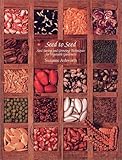
For the home seed saver, this might be the most useful book you can have. Since we’re growing all open pollinated and heirloom varieties, this book has been particularly helpful to us.
Seed to Seed provides essential information on how to germinate, grow, and save seed from almost any plant you could want to grow in your garden. This book is a necessity for the home gardener that’s just getting started with saving seed from heirloom and open pollinated varieties.
Plants are grouped into families, with information that applies to the members of the family given up front, then the specifics of each plant are presented. The common name index makes it easy to find the section you’re after, and the writeup for each variety provides almost everything you need to know to get started with that variety.
For each variety, you are told how to save its seed, what its optimal germination conditions are, how to isolate the plant or otherwise make sure the seed you collect is pure, seed statistics, and regional growing information.
One section of this book that we particularly appreciated was the section on hand pollination of squash blossoms. Since we are growing several varieties of squash, this is something we plan to implement (though the blossoms caught us off guard this year).
At the beginning of the book, there are a number of important sections about why we should save seed, about how pollination takes place and how to manage it for varietal purity, and seed cleaning and storage methods.
For the beginning gardener, do note that this book is not an all-purpose gardening book. The focus of this book is fairly focused and doesn’t provide a lot of information about soil, maintaining a garden, managing pests, or any of the other critical components of gardening. We recommend John Jeavons’ books How to Grow More Vegetables and Fruits and The Sustainable Vegetable Garden.
The only complaints about this book are that it is a little light on info about herbs and some regional varieties. Some herbs are presented, and the general information about pollination and seed collection teach enough to get you started. As for regional varieties, it’s fairly understandable that not everything can be included. The only thing we’ve found missing that we would have expected be there is pink-eyed purple-hulled peas.
Overall, this is a fantastic book with everything you’d need to get started saving seed besides the information on gardening in general, as you can’t save seed from a plant that doesn’t grow.